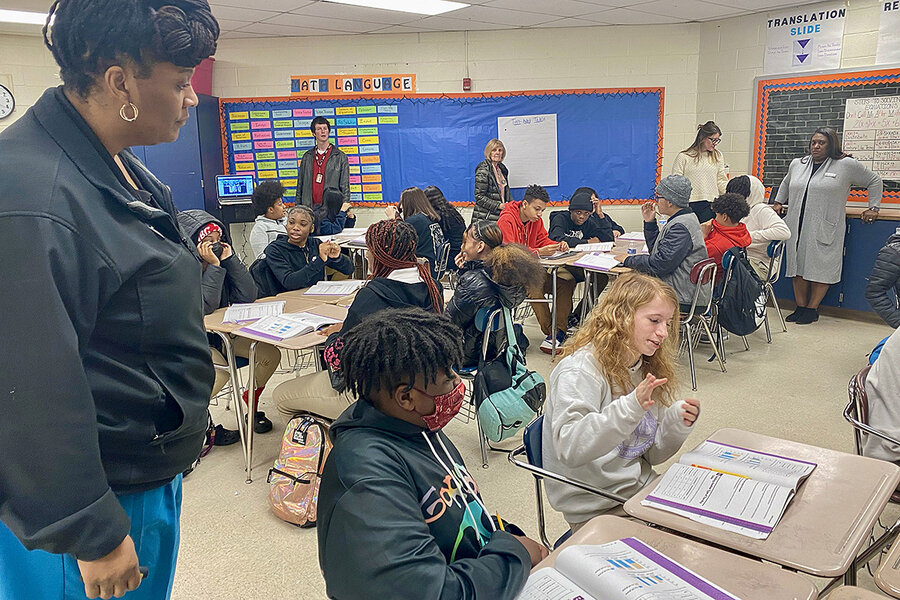Does math + pandemic money = help for struggling students?
Loading...
America’s teenagers have a math problem – one that can’t be solved with a few punches on a calculator. But schools have one unusual resource at their disposal – money, and lots of it.
Nearly $200 billion of federal pandemic aid has enabled some schools to bring on more tutors and adopt and enhance curriculum to bolster student learning.
Why We Wrote This
A story focused onU.S. schools have billions in federal pandemic funding to spend. But how much are they putting toward specific academic needs, such as boosting math skills?
The financial windfall carried relatively few guardrails. The federal government largely left it up to states and districts to spend as they saw fit. But how much are they putting toward specific academic needs, such as supporting floundering eighth graders with math? It’s difficult to say given the reporting differences between jurisdictions.
On a standardized test that samples students across the nation, only 26% of eighth graders in 2022 performed at or above a “proficient” level. That’s down from 34% in 2019, the last time students took the National Assessment of Educational Progress.
In a sense, it’s a dual race against time to help students close academic gaps and use the federal money, which has to be allocated by 2024, as the spending clock winds down.
“We are going to start our budget process super, super early,” says Corinne Colgan at the District of Columbia Public Schools, “to think about how we’re going to deal with the extra funds going away.”
America’s teenagers have a math problem – one that can’t be solved with a few punches on a calculator.
A steep drop in math test scores last year for eighth graders could hinder their movement through higher-level courses, and, ultimately, their job prospects, experts say. But as schools remediate academic shortfalls associated with the pandemic, they have one unusual resource at their disposal – money, and lots of it.
Nearly $200 billion of federal aid has enabled some schools to bring on more tutors, adopt and enhance curriculum, or pilot other programs designed to bolster student learning.
Why We Wrote This
A story focused onU.S. schools have billions in federal pandemic funding to spend. But how much are they putting toward specific academic needs, such as boosting math skills?
The financial windfall carried relatively few guardrails. The federal government largely left it up to states and districts to spend as they saw fit to reopen schools and address the pandemic’s effect on students.
But how much are they putting toward specific academic needs, such as boosting eighth graders’ math skills? It’s difficult to say given the reporting differences between jurisdictions – and the reluctance of many large districts to share details of their spending plans.
“They made very, very different decisions from one district to the next,” says Marguerite Roza, director of the Edunomics Lab at Georgetown University, which has been tracking COVID-19 funding expenditures. “And in that sense, it’s hard to get a pulse on anything looking like an average.”
Broad spending categories – such as “salaries” – don’t indicate whether the money went toward existing teachers or the hiring of, say, math interventionists to work specifically with struggling students.
In a sense, it’s a dual race against time to help students close academic gaps and use the federal money as the spending clock winds down. The deadline for U.S. school districts and state education agencies to budget the largest chunk of the Elementary and Secondary School Emergency Relief (ESSER) Fund money, $122 billion, is September 2024. There is a short window beyond that deadline to complete the spending.
An urgent priority: math
Declining math scores suggest why some schools have made the subject a priority. On a standardized test, only 26% of eighth graders in 2022 performed at or above a “proficient” level. That’s down from 34% in 2019, the last time students took the National Assessment of Educational Progress (NAEP), commonly known as the Nation’s Report Card.
It means that nearly three-quarters of students last year had not “demonstrated competency over challenging subject matter.” The average eighth grade math score was the lowest since 2003, underscoring the ways in which pandemic interruptions affected student learning.
On last year’s math test, a larger share of students – 60% of eighth graders – performed at the “basic” level, a step below proficient that indicates “partial mastery” of skills.
“If left unaddressed,” a NAEP official warned in a press release, “this could alter the trajectories and life opportunities of a whole cohort of young people.”
The math assessment analyzes students’ ability to classify angle measurements, use ratios, apply the Pythagorean theorem, and solve multistep equations, among other skills.
Those may sound like foreign concepts for people far removed from eighth grade, but experts say they’re skills that lay the groundwork for more complex algebra and geometry courses in high school.
“We want them to be confident. We want them to know they can persist through more challenging mathematical problems, such as what they’re going to see in Algebra I,” says Corinne Colgan, chief of teaching and learning for District of Columbia Public Schools. “I think it is a pivotal year.”
A student-centered approach
In Charlotte, North Carolina, the public schools have adopted a discourse and problem solving-based curriculum.
Of 26 districts that are part of NAEP’s Trial Urban District Assessment, a two-decade-old, opt-in group based on city size and student demographics, Charlotte-Mecklenburg Schools saw the largest share of eighth graders – 30% – perform at or above “proficient” on last year’s math assessment. On the other end of the spectrum, only 4% of eighth graders attending Detroit Public Schools Community District did so.
Leaders in Charlotte-Mecklenburg Schools say the curriculum adoption proved to be fortuitous: It occurred at the beginning of the 2019-2020 academic year, months before pandemic decisions plunged schools into remote learning.
The district has been funneling ESSER money toward professional development to support the curriculum. It’s just one of multiple ways they’re using the relief funds to improve eighth graders’ math skills.
District teacher Kyra Porter rarely instructs her students from the whiteboard. Instead, she meanders the classroom, asking questions that prompt discussion.
“Why do you think it’s called a two-way table?” Ms. Porter asks during a class observed via Zoom in mid-March.
As answers – and sometimes educated guesses – trickle in, she probes further. “What else, though?”
Slowly but surely, the students describe a table that has categorical variables. In this case, the information represents how many people in a certain age range have a cellphone. All the while, Ms. Porter keeps an eye out for those lightbulb moments when she sees students connecting the dots and understanding the underlying math concepts.
“They’re retaining the information more,” she says. “If you watch it in real time, it’s like the most beautiful thing.”
The district – like others across the nation – saw eighth graders’ average scores on the NAEP math test decline since 2019. Ms. Porter says teens’ math struggles aren’t that surprising given the nature of remote learning – with some students learning from parents or not at all, and teachers not easily able to gauge where students were making errors.
As of February, Charlotte-Mecklenburg Schools had spent 52% of its ESSER funds, committed another 17% of the money, and planned how to use 26% more of it, leaving only 5% unbudgeted, according to a presentation the district gave its board.
The district has budgeted nearly $204 million to offset learning loss through programs that provide students with additional learning time – such as a math enrichment program for fourth through eighth graders that began this spring – curriculum investments and related professional development, and extra school-based instructional staff, among other initiatives.
Charlotte educators say students need to be able to understand and apply math concepts, not just know the step-by-step procedures of solving a problem that, in today’s world, could easily be done by a machine. They hope the new approach to math instruction – bolstered by professional development from COVID-19 funding – changes students’ mindsets.
“We have a societal idea that it’s OK to not be good at math,” says Rob Leichner, a secondary math specialist at Charlotte-Mecklenburg Schools. “ ... But we’re changing that.”
Yasemin Copur-Gencturk, an associate professor of teacher education at the University of Southern California, applauds the district’s move to student-centered teaching. She’s urging districts to go a step further, too, and connect the dots between each lesson to deepen students’ understanding of math concepts.
“So instead of teaching standards one by one, teachers need to look at it and see how, you know, these concepts are building on each other,” she says.
At least one student has found herself warming up to math this year. Eighth grader Ariadna Castro Pinto says her confidence in math plummeted after the pandemic’s virtual learning.
When in-person schooling resumed, Ariadna says she felt behind. Now in Ms. Porter’s class, Ariadna says she has boosted her grades to mostly A’s or B’s, which she credits to the discussion-style approach.
“I really like when we discuss it, because we all put our parts [together] and then she just comes in and she’s like, ‘OK, so this is right. You’re on the right track,’” Ariadna says.
Sustaining investments
Several hundred miles to the north, the District of Columbia Public Schools (DCPS) is employing some of the same instructional strategies using ESSER money.
Seventeen percent of eighth graders attending public schools in the nation’s capital performed at or above the “proficient” level on the NAEP math test, placing the district roughly in the middle compared with its other urban peers.
DCPS has spent nearly 42% of its ESSER allocations, according to tracking done by the Edunomics Lab at Georgetown. District officials say some of that money has gone toward boosting eighth graders’ math achievement through a new student-centered curriculum, tutoring, professional development, and investment in a staff dedicated to an overall math strategy.
The district formed two Squads (Supporting Quality Academic Development for all Students) made up of strong math teachers who visit schools for a six-week period. They work shoulder-to-shoulder with teachers to build best practices that they hope will move the needle on student math achievement.
So far, it appears to be appreciated by the teachers receiving the mentoring, says Jennifer Burkett, director of math strategy and advancement for DCPS.
“At the end of the six weeks, they’re always like, ‘Can you stay longer? Can you please stay longer?’” she says.
Ms. Roza, the director of the Edunomics Lab, has been sounding the alarm that districts could face a “messy fiscal cliff,” especially if they put ESSER toward staff salaries.
DCPS leaders say they’re already preparing for the eventual funding decrease while evaluating initiatives.
“We are going to start our budget process super, super early to think about how we’re going to deal with the extra funds going away,” says Ms. Colgan. “Each year, we have tried to move a little bit more over to our operating budget.”
Now that many districts have already made spending decisions, experts say the next responsibility is perhaps even more important: tracking results to see what actually helped bridge students’ academic gaps.
But that’s reliant on mechanisms being put in place to do so.
“I’m worried,” Ms. Roza says, “that when this window closes, [it] closes, and we shift our attention to something else.”









